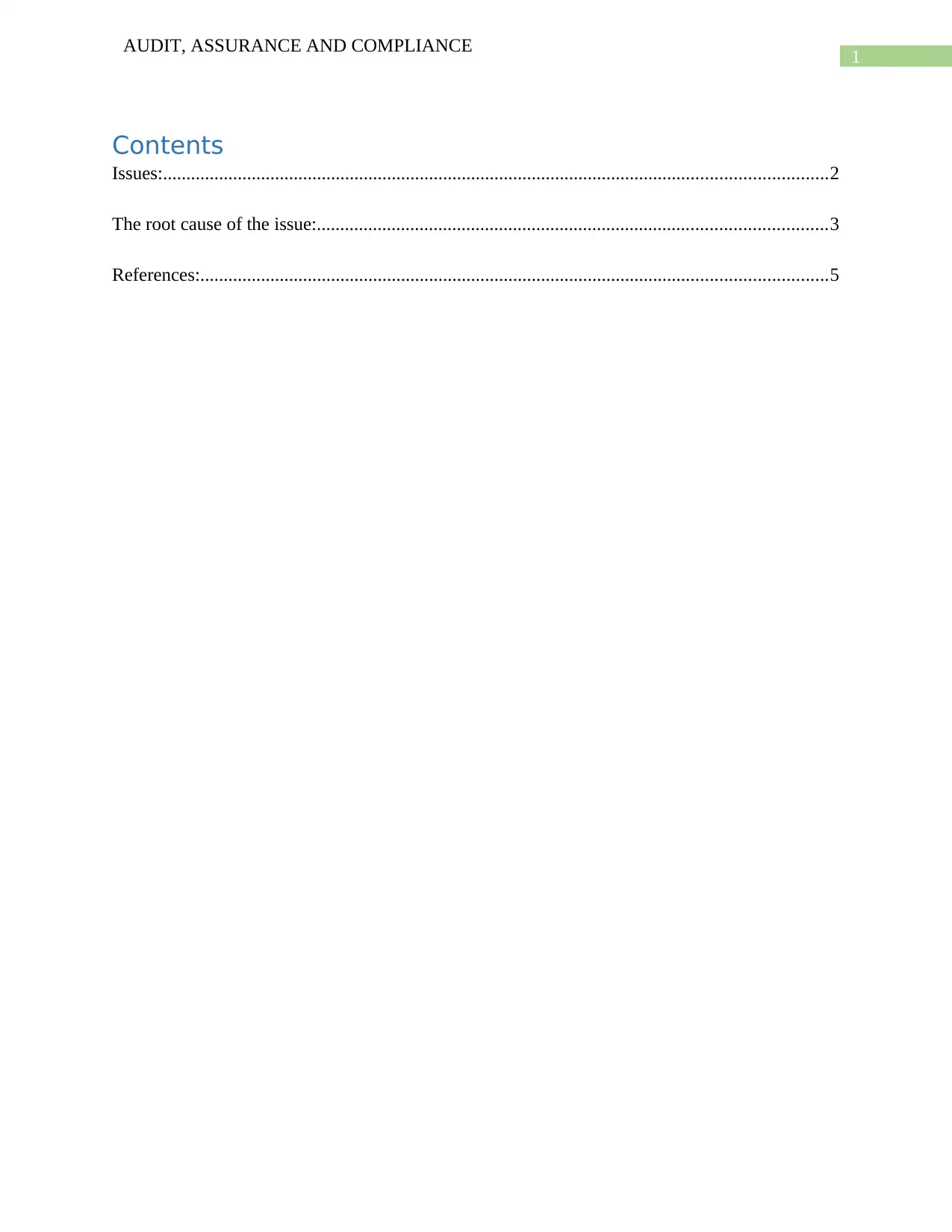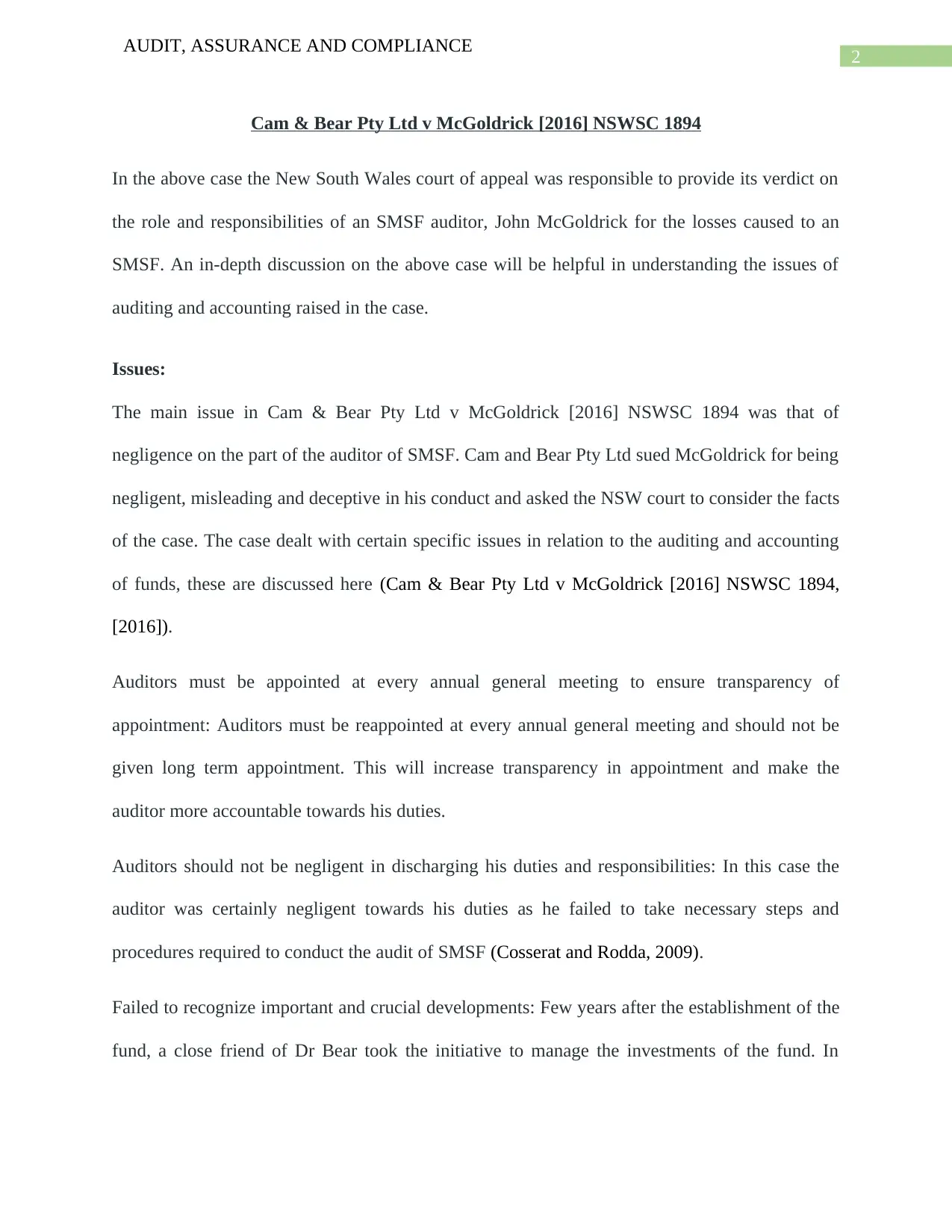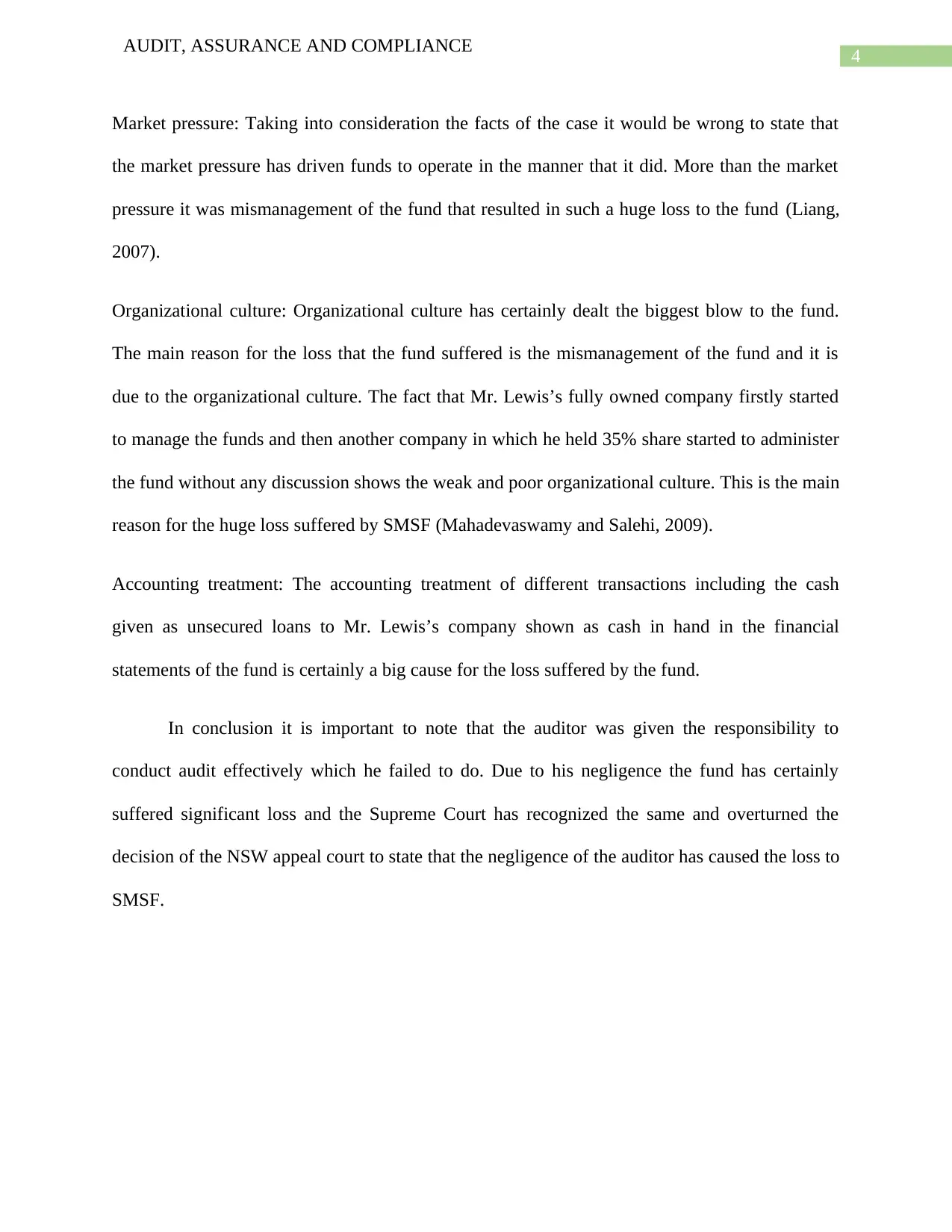Audit, Assurance and Compliance
VerifiedAdded on 2023/03/23
|6
|1111
|72
AI Summary
This document provides an in-depth discussion on the issues of auditing and accounting raised in the case of Cam & Bear Pty Ltd v McGoldrick [2016] NSWSC 1894. It discusses the negligence of the auditor, the root causes of the issues, and the resulting loss to the SMSF. The document also includes references for further reading.
Contribute Materials
Your contribution can guide someone’s learning journey. Share your
documents today.

Running head: AUDIT, ASSURANCE AND COMPLIANCE
Audit, Assurance and Compliance
Name of the Student:
Name of the University:
Authors Note:
Audit, Assurance and Compliance
Name of the Student:
Name of the University:
Authors Note:
Secure Best Marks with AI Grader
Need help grading? Try our AI Grader for instant feedback on your assignments.

1
AUDIT, ASSURANCE AND COMPLIANCE
Contents
Issues:..............................................................................................................................................2
The root cause of the issue:.............................................................................................................3
References:......................................................................................................................................5
AUDIT, ASSURANCE AND COMPLIANCE
Contents
Issues:..............................................................................................................................................2
The root cause of the issue:.............................................................................................................3
References:......................................................................................................................................5

2
AUDIT, ASSURANCE AND COMPLIANCE
Cam & Bear Pty Ltd v McGoldrick [2016] NSWSC 1894
In the above case the New South Wales court of appeal was responsible to provide its verdict on
the role and responsibilities of an SMSF auditor, John McGoldrick for the losses caused to an
SMSF. An in-depth discussion on the above case will be helpful in understanding the issues of
auditing and accounting raised in the case.
Issues:
The main issue in Cam & Bear Pty Ltd v McGoldrick [2016] NSWSC 1894 was that of
negligence on the part of the auditor of SMSF. Cam and Bear Pty Ltd sued McGoldrick for being
negligent, misleading and deceptive in his conduct and asked the NSW court to consider the facts
of the case. The case dealt with certain specific issues in relation to the auditing and accounting
of funds, these are discussed here (Cam & Bear Pty Ltd v McGoldrick [2016] NSWSC 1894,
[2016]).
Auditors must be appointed at every annual general meeting to ensure transparency of
appointment: Auditors must be reappointed at every annual general meeting and should not be
given long term appointment. This will increase transparency in appointment and make the
auditor more accountable towards his duties.
Auditors should not be negligent in discharging his duties and responsibilities: In this case the
auditor was certainly negligent towards his duties as he failed to take necessary steps and
procedures required to conduct the audit of SMSF (Cosserat and Rodda, 2009).
Failed to recognize important and crucial developments: Few years after the establishment of the
fund, a close friend of Dr Bear took the initiative to manage the investments of the fund. In
AUDIT, ASSURANCE AND COMPLIANCE
Cam & Bear Pty Ltd v McGoldrick [2016] NSWSC 1894
In the above case the New South Wales court of appeal was responsible to provide its verdict on
the role and responsibilities of an SMSF auditor, John McGoldrick for the losses caused to an
SMSF. An in-depth discussion on the above case will be helpful in understanding the issues of
auditing and accounting raised in the case.
Issues:
The main issue in Cam & Bear Pty Ltd v McGoldrick [2016] NSWSC 1894 was that of
negligence on the part of the auditor of SMSF. Cam and Bear Pty Ltd sued McGoldrick for being
negligent, misleading and deceptive in his conduct and asked the NSW court to consider the facts
of the case. The case dealt with certain specific issues in relation to the auditing and accounting
of funds, these are discussed here (Cam & Bear Pty Ltd v McGoldrick [2016] NSWSC 1894,
[2016]).
Auditors must be appointed at every annual general meeting to ensure transparency of
appointment: Auditors must be reappointed at every annual general meeting and should not be
given long term appointment. This will increase transparency in appointment and make the
auditor more accountable towards his duties.
Auditors should not be negligent in discharging his duties and responsibilities: In this case the
auditor was certainly negligent towards his duties as he failed to take necessary steps and
procedures required to conduct the audit of SMSF (Cosserat and Rodda, 2009).
Failed to recognize important and crucial developments: Few years after the establishment of the
fund, a close friend of Dr Bear took the initiative to manage the investments of the fund. In

3
AUDIT, ASSURANCE AND COMPLIANCE
addition Anthony Lewis further decided that a company in which he holds 35% interest to
administer the fund. All these developments should have been carefully noticed by the auditor.
Inability to use appropriate audit procedures to carry out an effective audit: The auditor failed to
use appropriate audit procedures to find out problems in management of the funds over the years.
Lack of physical verification of fund’s assets: The fund’s assets not physically verified by the
auditor. As a result cash which constituted significant portion of fund’s assets was lent to Mr
Lewis’s company without any security and without the consent of the trustees of the fund. Such
huge mismanagement of the fund gone unnoticed due to the negligence of the auditor (Holm,
Langsted and Seehausen, 2011).
Wrong accounting treatment:
The unsecured loan given to Mr Lewis’s company by the fund was shown as cash-LSL Holding
P/L. The unsecured loan is an investment of the fund instead the same was shown as cash in the
books of accounts of the fund.
Voluntary liquidation of Mr Lewis’s company resulted in complete loss of funds to SMSF: As
the cash was provided as unsecured loans to Mr Lewis’s company Dr Bear failed to recover the
money subsequent to the voluntary liquidation of the company.
The root cause of the issue:
From the above discussion it is clear that McGoldrick was very negligent in his behavior as the
auditor of SMSF. This resulted in huge loss to the fund. The root cause of the above issues are
explained here.
AUDIT, ASSURANCE AND COMPLIANCE
addition Anthony Lewis further decided that a company in which he holds 35% interest to
administer the fund. All these developments should have been carefully noticed by the auditor.
Inability to use appropriate audit procedures to carry out an effective audit: The auditor failed to
use appropriate audit procedures to find out problems in management of the funds over the years.
Lack of physical verification of fund’s assets: The fund’s assets not physically verified by the
auditor. As a result cash which constituted significant portion of fund’s assets was lent to Mr
Lewis’s company without any security and without the consent of the trustees of the fund. Such
huge mismanagement of the fund gone unnoticed due to the negligence of the auditor (Holm,
Langsted and Seehausen, 2011).
Wrong accounting treatment:
The unsecured loan given to Mr Lewis’s company by the fund was shown as cash-LSL Holding
P/L. The unsecured loan is an investment of the fund instead the same was shown as cash in the
books of accounts of the fund.
Voluntary liquidation of Mr Lewis’s company resulted in complete loss of funds to SMSF: As
the cash was provided as unsecured loans to Mr Lewis’s company Dr Bear failed to recover the
money subsequent to the voluntary liquidation of the company.
The root cause of the issue:
From the above discussion it is clear that McGoldrick was very negligent in his behavior as the
auditor of SMSF. This resulted in huge loss to the fund. The root cause of the above issues are
explained here.
Secure Best Marks with AI Grader
Need help grading? Try our AI Grader for instant feedback on your assignments.

4
AUDIT, ASSURANCE AND COMPLIANCE
Market pressure: Taking into consideration the facts of the case it would be wrong to state that
the market pressure has driven funds to operate in the manner that it did. More than the market
pressure it was mismanagement of the fund that resulted in such a huge loss to the fund (Liang,
2007).
Organizational culture: Organizational culture has certainly dealt the biggest blow to the fund.
The main reason for the loss that the fund suffered is the mismanagement of the fund and it is
due to the organizational culture. The fact that Mr. Lewis’s fully owned company firstly started
to manage the funds and then another company in which he held 35% share started to administer
the fund without any discussion shows the weak and poor organizational culture. This is the main
reason for the huge loss suffered by SMSF (Mahadevaswamy and Salehi, 2009).
Accounting treatment: The accounting treatment of different transactions including the cash
given as unsecured loans to Mr. Lewis’s company shown as cash in hand in the financial
statements of the fund is certainly a big cause for the loss suffered by the fund.
In conclusion it is important to note that the auditor was given the responsibility to
conduct audit effectively which he failed to do. Due to his negligence the fund has certainly
suffered significant loss and the Supreme Court has recognized the same and overturned the
decision of the NSW appeal court to state that the negligence of the auditor has caused the loss to
SMSF.
AUDIT, ASSURANCE AND COMPLIANCE
Market pressure: Taking into consideration the facts of the case it would be wrong to state that
the market pressure has driven funds to operate in the manner that it did. More than the market
pressure it was mismanagement of the fund that resulted in such a huge loss to the fund (Liang,
2007).
Organizational culture: Organizational culture has certainly dealt the biggest blow to the fund.
The main reason for the loss that the fund suffered is the mismanagement of the fund and it is
due to the organizational culture. The fact that Mr. Lewis’s fully owned company firstly started
to manage the funds and then another company in which he held 35% share started to administer
the fund without any discussion shows the weak and poor organizational culture. This is the main
reason for the huge loss suffered by SMSF (Mahadevaswamy and Salehi, 2009).
Accounting treatment: The accounting treatment of different transactions including the cash
given as unsecured loans to Mr. Lewis’s company shown as cash in hand in the financial
statements of the fund is certainly a big cause for the loss suffered by the fund.
In conclusion it is important to note that the auditor was given the responsibility to
conduct audit effectively which he failed to do. Due to his negligence the fund has certainly
suffered significant loss and the Supreme Court has recognized the same and overturned the
decision of the NSW appeal court to state that the negligence of the auditor has caused the loss to
SMSF.

5
AUDIT, ASSURANCE AND COMPLIANCE
References:
Cam & Bear Pty Ltd v McGoldrick [2016] NSWSC 1894 [2016] 2 (NSW court).
Cosserat, G. and Rodda, N. (2009). Modern auditing. 5th ed. Chichester, UK: John Wiley &
Sons, pp.12-127.
Holm, C., Langsted, L. and Seehausen, J. (2011). Establishing Proactive Auditor Responsibilities
in Relation to Fraud: The Role of the Courts and Professional Bodies in
Denmark. International Journal of Auditing, 16(1), pp.79-97.
Liang, B. (2007). Hedge Fund Returns: Auditing and Accuracy. SSRN Electronic Journal, 2(5),
pp.18-27.
Mahadevaswamy, G. and Salehi, M. (2009). Audit Expectation Gap in Auditor Responsibilities:
Comparison between India and Iran. International Journal of Business and Management,
3(11), pp.11-23.
AUDIT, ASSURANCE AND COMPLIANCE
References:
Cam & Bear Pty Ltd v McGoldrick [2016] NSWSC 1894 [2016] 2 (NSW court).
Cosserat, G. and Rodda, N. (2009). Modern auditing. 5th ed. Chichester, UK: John Wiley &
Sons, pp.12-127.
Holm, C., Langsted, L. and Seehausen, J. (2011). Establishing Proactive Auditor Responsibilities
in Relation to Fraud: The Role of the Courts and Professional Bodies in
Denmark. International Journal of Auditing, 16(1), pp.79-97.
Liang, B. (2007). Hedge Fund Returns: Auditing and Accuracy. SSRN Electronic Journal, 2(5),
pp.18-27.
Mahadevaswamy, G. and Salehi, M. (2009). Audit Expectation Gap in Auditor Responsibilities:
Comparison between India and Iran. International Journal of Business and Management,
3(11), pp.11-23.
1 out of 6
Your All-in-One AI-Powered Toolkit for Academic Success.
+13062052269
info@desklib.com
Available 24*7 on WhatsApp / Email
![[object Object]](/_next/static/media/star-bottom.7253800d.svg)
Unlock your academic potential
© 2024 | Zucol Services PVT LTD | All rights reserved.


